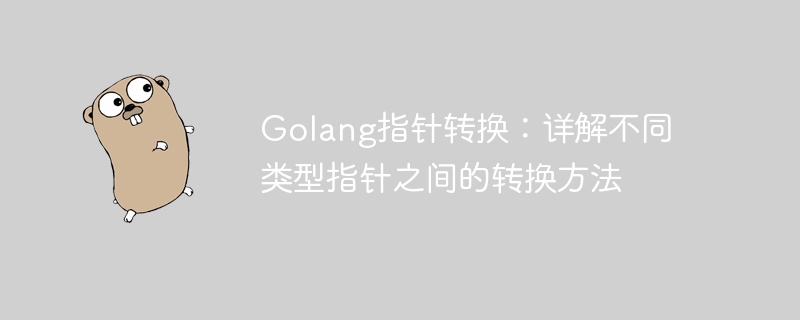Home >Backend Development >Golang >Convert Golang pointers: Analyze conversion methods between different types of pointers
Convert Golang pointers: Analyze conversion methods between different types of pointers
- WBOYWBOYWBOYWBOYWBOYWBOYWBOYWBOYWBOYWBOYWBOYWBOYWBOriginal
- 2024-02-25 23:12:23724browse

Golang pointer conversion: Detailed explanation of conversion methods between different types of pointers
In Golang programming, pointers are a very important data type, which can be used Pass the address of data to reduce data copying and improve performance. However, in actual development, we sometimes encounter conversion problems between different types of pointers, such as converting int type pointers to string type pointers. This article will explore in detail the conversion methods between different types of pointers and provide specific code examples.
Pointer Overview
First, let’s review the basic concepts of pointers. A pointer is a variable whose value is the address of another variable. Through pointers, we can directly access or modify the value of the target variable. In Golang, by adding the & symbol in front of a variable, you can get the address of the variable; by adding the * symbol in front of the pointer variable, you can get the target variable pointed to by the pointer variable. .
Pointer conversion method
In Golang, conversion between different types of pointers usually requires the use of methods in the unsafe package, because Golang is a type-safe language. In general, direct pointer type conversion is not allowed. Here are several common pointer conversion methods:
1. Pointer type conversion
import (
"unsafe"
)
func main() {
var i int = 42
var p *int
p = &i
var ps *string
ps = (*string)(unsafe.Pointer(p))
// 此时 ps 指向的地址仍为 i 的地址,但类型已经转换为 *string
}2. Pointer value conversion
import (
"unsafe"
)
func main() {
var i int = 42
var p *int
p = &i
pi := uintptr(unsafe.Pointer(p))
ps := (*string)(unsafe.Pointer(pi))
// ps 现在指向的地址为 i 的地址对应的字符串值,但类型为 *string
}3. Conversion of the value pointed by the pointer
import (
"unsafe"
)
func main() {
var i int = 42
var p *int
p = &i
pv := unsafe.Pointer(p)
ps := (*string)(pv)
// ps 指向的值为 i 的值对应的字符串,类型为 *string
}Notes
- When performing pointer conversion, be sure to ensure the safety and correctness of the conversion operation to avoid memory leaks or program crashes.
- Try to avoid frequent use of pointer conversion operations to avoid increasing the complexity of the code and reducing the readability of the code.
- For pointer conversion operations, it is recommended to use them when clearly needed to ensure the stability and maintainability of the code.
Conclusion
This article introduces in detail the conversion methods between different types of pointers in Golang, provides specific code examples, and emphasizes the matters that need to be paid attention to when performing pointer conversion. . Through studying this article, I believe that readers will have a deeper understanding of Golang pointer conversion. I hope this article can be helpful to everyone's study and practice.
The above is the detailed content of Convert Golang pointers: Analyze conversion methods between different types of pointers. For more information, please follow other related articles on the PHP Chinese website!

